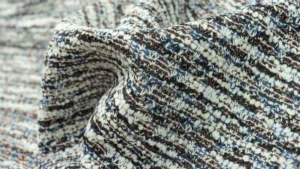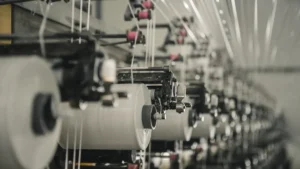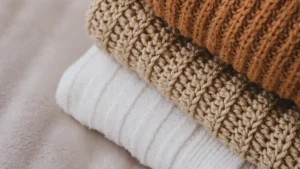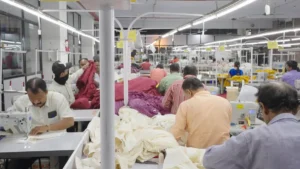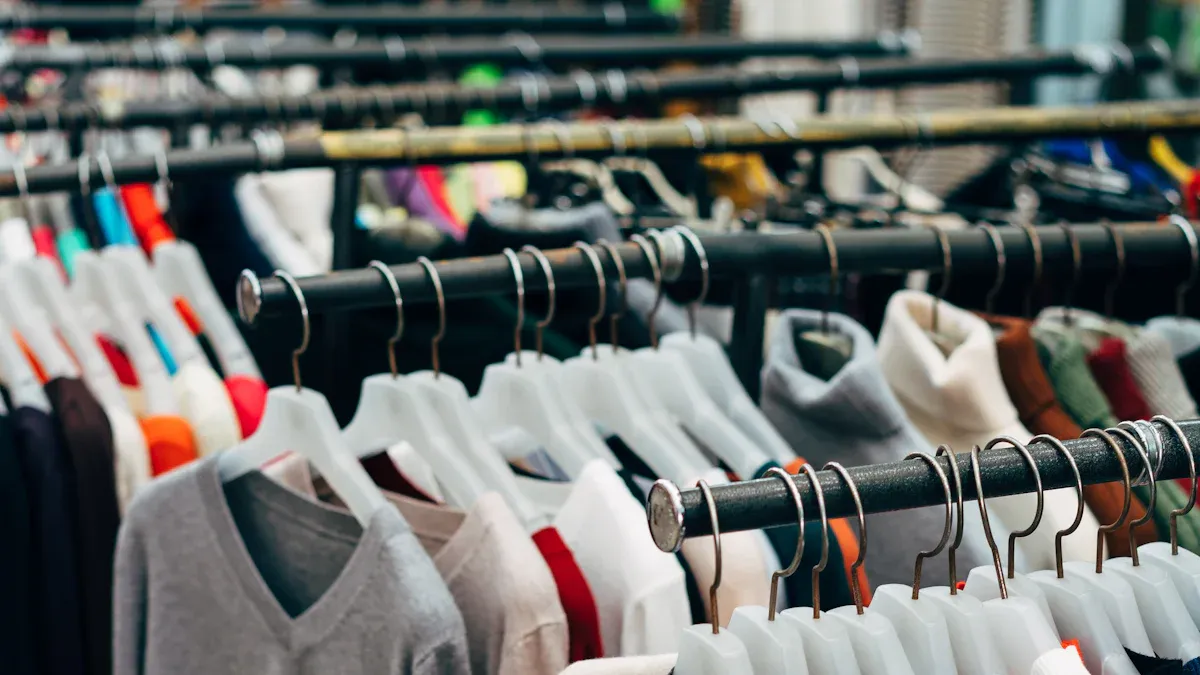
Knit Dress Factories make stylish, high-quality clothes in large amounts. They do this by using new technology, skilled workers, and careful checks. When a popular knit dress is shown on the runway, factories use computer knitting machines. They also use seamless garment production to make many dresses that look like the original.
Statistic/Aspect | Value/Description |
|---|---|
Global Market Size (2023) | |
Technological Advancements | Smart knitting machines, automation, and IoT integration help make clothes faster and with more designs |
Design Innovation | Lets factories create detailed patterns, seamless clothes, and use eco-friendly knitting methods |
Factories also care about how they get their materials:
They use less water and fewer chemicals.
This helps people trust the products and makes them last longer.
Key Takeaways
Knit dress factories use smart machines and AI. They quickly make runway designs into stylish dresses. These dresses are high-quality and have less waste.
Factories pick eco-friendly materials. They follow strict checks to make strong dresses. Customers trust these dresses.
Skilled workers and clear steps help factories. They keep mistakes low. They also make production faster and better.
Automation and data tools help factories work faster. They make fewer errors. Factories can deliver big orders on time.
Strong partnerships with suppliers help factories. Ongoing training helps too. Factories balance creativity, quality, and scale well.
Knit Dress Factories and Style Innovation

Design Translation
Knit Dress Factories help turn ideas from the runway into real dresses. Designers and factory teams work together to match every detail. They use special tools to make this faster and avoid mistakes.
AI generative design tools let designers try many dress ideas on a computer. This means they do not have to make a real dress for each idea. It saves time and uses fewer materials.
3D renderings and simulations show how a dress will look and move. Patternmakers can change designs before making the first real dress.
Factories use what shoppers think early in the process. AI platforms show lots of designs to people and pick the favorites. This helps factories avoid making dresses that no one wants.
3D body scanning lets factories make dresses that fit each person well. Automated pattern generation helps with this.
Micro-factories, like at Pensole Lewis College, use 3D knitting machines to make custom sweaters right there. Inbarico, a Spanish bridal brand, uses local micro-factories to 3D print wedding dresses in small groups.
Note: These steps help factories go from design to making dresses quickly and with less waste.
Metric | Description | Example Value | Importance in Translating Design to Production |
|---|---|---|---|
Lead Time | Time from design to production | Helps launch on time and follow trends | |
Production Yield | Percentage of usable products produced | 95% | Makes sure quality is high and waste is low |
Supply Chain Cycle Time | Time from idea to delivery | 4 weeks | Shows how fast ideas become real products |
Quality Index | 98% satisfied | Keeps the brand strong and products good | |
Average Order Value | Average customer spend per transaction | $120 | Helps with pricing and marketing |
Employee Productivity | Units produced per labor hour | 15 units/hr | Shows how well workers make dresses |
Technology Integration
Knit Dress Factories use advanced knitting machines like Stoll and Shima. These machines make high-quality dresses with custom patterns and smooth fits. Seamless knitting technology makes dresses more comfortable and helps them fit better.
Advanced knitting machines help factories work faster and make fewer mistakes. Computerized and automated systems let factories make dresses quickly. These machines also help save fabric. Factories can make special patterns and styles for each order. Robotics, IoT, and AI help keep costs down and quality up.
A modern factory might use AI and brain-computer interface (BCI) technology. A technician can control machines with BCI and augmented reality. This helps fix problems fast and keeps quality high. Most factories now use fully automatic machines. This shows they care about being precise and productive.
Performance Category | Indicators Supporting Design Fidelity Enhancement |
|---|---|
Percentage of planned production achieved; Machine downtime percentage | |
Quality Control | Defect rate in knitted products; Percentage of products meeting quality standards |
Resource Utilization | Machine utilization rate; Labor productivity (output per hour) |
Waste Management | Percentage of raw material wastage; Efficiency in recycling and reusing materials |
Lead Time | Average production lead time; On-time delivery performance |
Cost Management | Cost per unit produced; Difference between planned and real costs |
Employee Training | Number of training hours per employee; Skill improvement rate |
Process Optimization | Finding and using better ways to work; Making knitting machines work better |
Quality Assurance | Keeping quality checks in place; Always working to make products better |
Seamless knitting technology is important in the industry. It lets factories make dresses that feel soft and fit well. This technology also cuts down on steps to finish each dress. It makes the process faster and more efficient.
Quality Control in Knit Dress Factories
Material Selection
Choosing the right materials is very important for making good knit dresses. Factories pick yarns and fibers carefully. They want them to work well and be good for the planet. Many factories use organic cotton, recycled polyester, and eco-friendly blends. These choices help save water and cut down on chemical waste. Factories also make sure their suppliers treat workers fairly and follow the rules for the environment.
Factories often buy from trusted suppliers who give certificates for their yarns. This makes sure every batch is the right color, strong, and soft. Using good materials helps dresses last longer and feel nice to wear.
Note: Getting materials in a good way helps customers trust the brand and keeps the brand strong for a long time.
Skilled Labor and SOPs
Skilled workers are very important for keeping quality high. They run knitting machines, watch the work, and fix problems fast. Training helps workers learn new things and keep up with new machines.
Standard operating procedures (SOPs) tell workers what to do at each step. SOPs give clear rules for machine settings, yarn use, and checking the work. This helps stop mistakes and keeps quality high. After SOPs started, more dresses passed the first check. Fewer dresses needed fixing, and more passed the last check. Factories saved a lot of time and money.
Metric / Parameter | Before SOP Implementation | After SOP Implementation | Improvement (%) | Notes / Impact Summary |
|---|---|---|---|---|
First-Pass Yield (RFT) | 73% | 88% | +20% | 60,000+ more first-pass pieces per month |
Rework Rate | 9.5% | 6.1% | -36% | 13,600+ rework hours saved annually |
Final Audit Pass Rate | 85% | 95% | +10% | 40,000+ extra pieces cleared without re-audit |
SOPs also help stop yarn downtime and color problems. Training and taking care of machines keep the work smooth and fast.
Multi-Stage Checks
Knit Dress Factories check quality at many steps to make sure every dress is good. Checks start with the raw materials and go through knitting, sewing, and finishing. Inspectors look at size, color, and how well the dress is made. They also test if the dress is strong and does not get fuzzy.
Factories use digital tech packs and cloud systems to keep track of every order. These tools help make sure all the details are the same and let people see updates right away. Automated checks and RFID tracking help find problems early. Inline checks catch mistakes before the next step. Final checks make sure only the best dresses go to customers.
Checking at many steps helps factories waste less and avoid delays. It also makes dresses more alike and keeps customers happy. These ways help factories make lots of good knit dresses.
Scaling Production with Technology
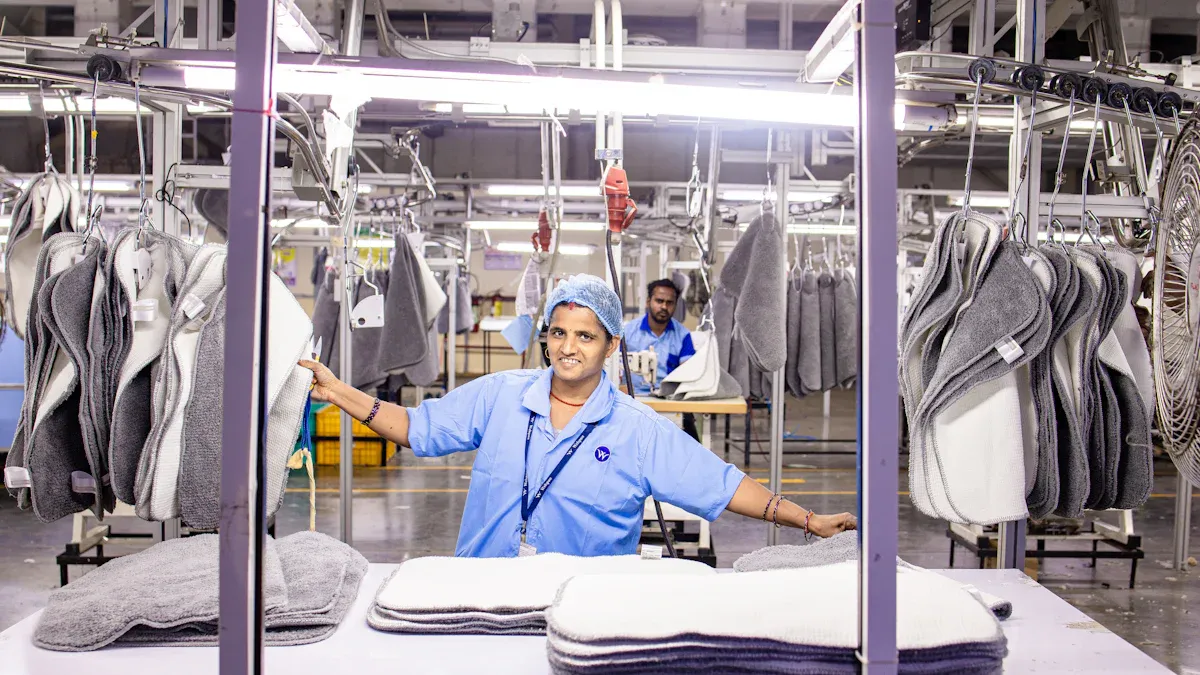
Automation and Data
Knit dress factories use automation and data to work faster. Smart machines with artificial intelligence change fabric tension and stitch size as they work. These machines help stop mistakes and make sure each dress is the same. Optical sensors look for problems before cutting the fabric. This saves materials and cuts down on waste. Robots do jobs like spooling, checking, and packing. This lets workers do harder tasks.
Factories use AI software to plan and control their work. The software makes schedules, manages supplies, and checks progress. Predictive maintenance tools watch machines and warn teams before something breaks. This keeps machines working longer and stops delays. Automated cutting machines use computer designs to cut fabric very accurately. This helps prevent mistakes.
Automation helps factories work faster and keeps workers safe. It also helps factories finish orders on time.
Aspect | Data-Driven Approach (AI) Impact | Quantitative Result |
|---|---|---|
Production Output | Optimized line scheduling | |
Downtime Reduction | Predictive maintenance | 50% less downtime |
Quality Control | AI vision for defect detection | 90% fewer defective products |
Inventory Management | Real-time tracking and demand forecasting | Lower costs, better cash flow |
Supply Chain Management
Factories use advanced supply chain systems for big orders. Automated supply chain management uses blockchain and Big Data to track every step. This goes from getting yarn to making finished dresses. The system shares quality data right away and helps find problems early. It also builds trust between suppliers and factories.
Pilot batch testing checks small groups of dresses before making a lot. This finds problems early and makes sure the final dresses are good. Automated systems help factories react fast to changes in orders or supplies. They also lower the chance of delays, mistakes, and fake products. With these tools, knit dress factories make high-quality dresses on time and in large amounts.
Balancing Style, Quality, and Scale
Coordination Strategies
Factories need to mix creativity, quality, and speed to do well. They use standard operating procedures, or SOPs, to make each step easy to follow. Some factories make SOP videos in two languages so all workers can understand. This helps workers make fewer mistakes and keeps the quality high. Factories check machines often and have regular quality checks to keep things the same. When factories spend money on skilled workers and training, workers learn new things and use new machines. Training classes and workshops help teams get better and fix fewer mistakes.
Factories use data to watch how things are made and find problems fast. Digital systems track where mistakes happen the most. If factories find problems early, they can fix them before they get worse. Factories check quality at many steps, like before making and during making, to stop returns. Automation and technology, like CAD software and AI planning, help factories make more dresses without losing quality. Good suppliers with quality certificates make sure materials stay the same, even for big orders.
Strategic Partnerships
Knit Dress Factories work closely with partners to get better and make good products. They pick suppliers with quality certificates and check them often. These partnerships help keep materials the same and lower mistakes. Factories build testing centers with new tools to check fabric and finished dresses. Automated checks and sensors help find problems faster and more accurately.
Factories also train workers who do very well. They give these workers more important jobs to help make better dresses. Factories use the Pareto Principle to give hard jobs to the best workers and watch the machines that make the hardest designs. Data helps factories guess where problems might happen and make things better. Factories also care about being fair and good to the planet, which helps their brand and makes customers happy.
Factories can change quickly and talk clearly with clients. This helps them follow new trends and special requests. It lets factories make stylish, high-quality dresses in large amounts.
Today’s factories mix new ideas, smart machines, and careful checks to make lots of stylish knit dresses. They use AI-powered machines to spot mistakes and keep things the same. 3D knitting helps make seamless and custom dresses. Digital twins help factories work faster and waste less.
Technology Trend | Benefit for Production and Quality |
|---|---|
AI-Powered Knitting | Finds mistakes and keeps dresses alike |
3D Knitting Technology | Makes seamless and custom dresses |
Digital Sampling | Helps dresses fit better and saves time |
If brands want the best, they should pick a partner with good technology, eco-friendly ways, and a strong record. Ask for a development pack, fabric samples, or a lookbook to see these benefits yourself.
FAQ
How do knit dress factories keep up with fashion trends?
Factories watch runway shows and use AI to spot new trends. Designers and technicians work together to make new dresses fast. This helps brands stay trendy and give customers what they want.
What materials do factories use for sustainable knit dresses?
Factories pick organic cotton, recycled polyester, and eco-friendly blends. They buy from suppliers who have certificates for good sourcing. These choices help the planet and support fair factories.
How do factories ensure every dress meets quality standards?
Factories check quality at many steps. Inspectors look at materials, watch the work, and test finished dresses. Digital systems help find problems early. This makes sure each dress is high quality.
Can factories produce custom knit dresses at scale?
Factories use advanced knitting machines and digital design tools. These let them change styles and patterns quickly. Brands can order special dresses in big amounts and still get good quality.
What role does automation play in knit dress production?
Automation makes work faster and cuts down on mistakes. Smart machines change settings by themselves. Robots do jobs like packing. This helps factories finish big orders on time and keep quality high.



